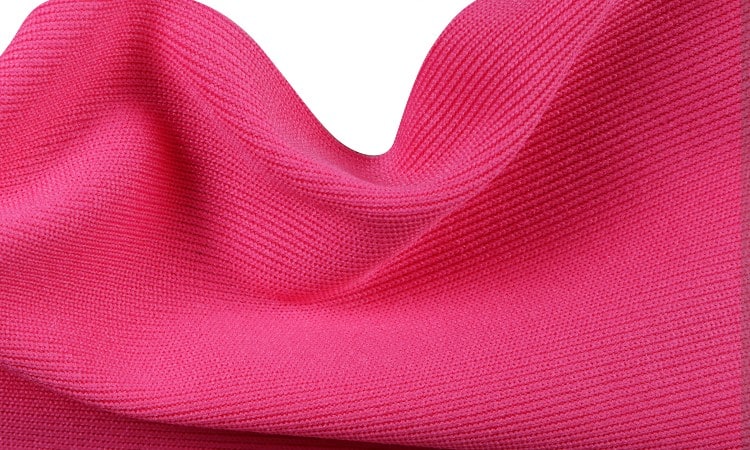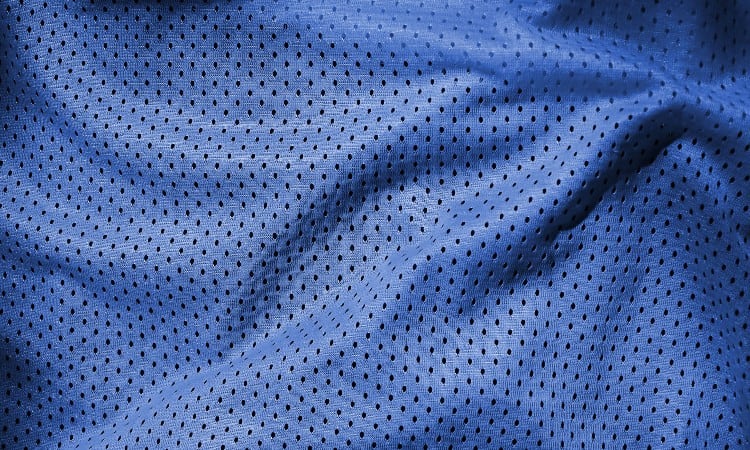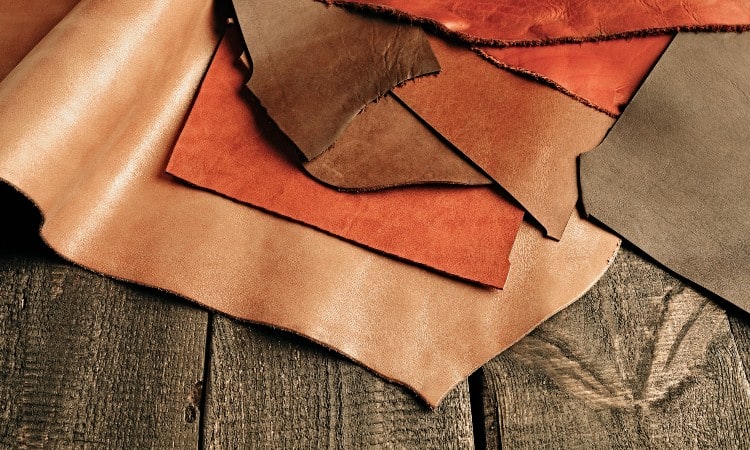Polyester and leather are both popular and versatile materials. But which one should I use for my next project? Can I cover my sofa with polyester? Or make sportswear out of leather? When it comes to polyester vs leather, what’s the difference? Which is better?
The main difference between polyester and leather is one is man-made and the other is natural. Polyester is petroleum-based. Synthetic and lightweight, polyester makes great outerwear and sportswear. Leather is animal skin and completely natural. As a heavy-weight fabric, leather’s used for furniture, jackets, and bags. It’s both durable and hard-wearing.
With one being a natural material and the other a synthetic, they will behave differently. In this article, we’ll look at the pros and cons of polyester vs leather. Read on to find out what’s the difference and which is better.

Polyester vs Leather: Key Points
Comparing leather and polyester is a bit like looking at the differences between cars and trucks. A truck will get you from A to B, but the drive will be quicker and more comfortable in a car. Similarly, you can make a jacket out of polyester, but it will look more stylish in leather.
Let’s take a look at some of the characteristics of polyester and leather to identify the pros and cons of each. That way, we can start to pinpoint which material is better suited for any particular project. We’ll look at the properties highlighted in the following table in more detail later in the article.
| Characteristics | Polyester | Leather |
|---|---|---|
| Care and Maintenance | Easy care – wash and go Machine washable on a cold setting. Air dry | Depends on the grade of leather. Some require special care with specific leather products. Even dry cleaning can cause damage or make seams/blemishes stand out more on softer leathers |
| Comfort | Soft and smooth from the start | Can be stiff but softens with age and regular use |
| Content | Synthetic fiber derived from petroleum | Not a fiber. It’s animal skin |
| Cost | Inexpensive | Expensive |
| Durability | Durable | Durable |
| Shrinking | Does not shrink | Can shrink |
| Sustainability | Not really. It’s not biodegradable and the production process uses natural resources | Up to a point, although slightly contentious. Could be considered sustainable if produced from animals killed for the meat industry. Not really sustainable if animals are farmed specifically for leather |
| Uses | Clothing, bedsheets, outerwear, sportswear, artificial stuffing, ropes, plastic bottles | Bags, coats, skirts, pants, motorcycle safety wear, upholstery, wallets, belts, shoes |
What Is Polyester?

Polyester has become one of the most popular synthetic fibers available today. Derived from petroleum, it is used for many items, from plastic bottles to waterproof raincoats.
Originally developed by DuPont and presented to the public in the 1950s, the fiber has revolutionized clothing fabric by providing a cheaper alternative to natural fibers, particularly cotton.
After an initial rise in popularity in the 1970s, the fabric went out of favor. Early polyesters were uncomfortable to wear. Hot and clammy if the weather was warm and cold if the temperature dropped. A main bone of contention was the fabric felt like plastic next to the skin.
Today’s polyester has come a long way since then. With modern technology and improved production processes, it’s getting harder to tell polyesters from their natural fiber counterparts.
Easy to care for and resistant to wrinkles, polyester is a wash-and-go fabric that will withstand regular trips to the laundry. The fabric won’t shrink or stretch and is hypoallergenic. Another benefit, moths hate it and mildew can’t form on it.
Pros
- Inexpensive
- Can be blended with natural fibers for added comfort
- Crease-resistant
- Does not need ironing
- Durable
- Lightweight
- Quick-drying
- Newer versions have some moisture-wicking capability
Cons
- Does not breathe
- Feels cold against the skin
- Can feel clammy in hot weather
- Heat intolerant
- Can pill easily
- Can be damaged by fasteners on other garments during a wash cycle
- Not environmentally friendly
What Is Leather?

Leather is one of the oldest materials known to man. Archaeological evidence has discovered leather at sites throughout the world dating as far back as 10,500 years ago! This means leather has been used for clothing and shelter for 1000s of years.
Technically, leather is neither fabric or fiber. It’s animal skin. One of the little-known facts about leather is it can be made from almost any animal or even reptile. Skin from alligators, ostriches, kangaroos, goats, pigs, frogs, rabbits, snakes, elk, and deer can all be used to produce leather.
It can come in three forms. When the outside of the skin is used, it’s called leather. If the inside or flesh side is used, it’s called suede. Sometimes, in the case of sheep in particular, if the wool is left intact, it is known as sherpa.
Most of us think of cattle when we think about where leather comes from. It is one of the more popular forms of leather, but goats, pigs, and sheep are also good sources for modern-day leather requirements.
Depending on the animal or reptile donating the skin and the part of the animal it came from, the resulting leather can have different properties. It can be super soft and pliable or tough as old boots and too thick to bend.
The popularity of leather is down to the stylish, fashionable garments it can be used to make. Both long-lasting and highly durable, leather can be cut to make pants or warming winter coats.
Its durability makes it one of the most versatile protective materials. Pilots wore leather bomber jackets during World War 2 to keep them warm in the cockpit and offer protection in crashes. Even motorcyclists wear leather gear as protection against injury.
Pros
- Comes in a range of weights and thicknesses
- Warming and protective
- Durable
- Gets softer with age and use
- Long-lasting
- Waterproof
Cons
- Sometimes sold by the skin not the yard
- Some leather can be easily damaged by moisture
- Expensive
- Can be damaged by cleaning
- Processing leather can leave marks that show on the final garment
- Easily damaged by pins
- Can shrink
- Prone to mildew
Polyester vs Leather: Which Is Better?
We’ve looked at the pros and cons of both leather and polyester individually. Now, let’s take a look at how those characteristics fair in a polyester vs leather contest. In this section, we’ll compare the two materials to see which one comes out best for each listed property.
Breathability

The definition of breathable fabric is one that can wick moisture away from the skin and regulate body temperature for the wearer. Natural fibers, cotton for example, have breathability.
As a synthetic fiber, polyester scores badly for this characteristic. Synthetic or manmade fibers are known to be non-breathable fabrics. Although polyester does wick moisture to a certain extent, it doesn’t let it evaporate into the atmosphere. Most polyesters will trap the moisture between the fabric and skin, making you feel sticky. This is one reason polyester is so uncomfortable when worn as a base layer.
Leather is a natural product and has breathable qualities up to a point. The level or extent of the breathability relies on the thickness of the leather in question. Some types are more breathable than others. Shoe leather is particularly breathable and helps relieve or reduce the chances of overly sweaty feet.
As a fabric, leather can be a bit warm to wear, so it can’t keep you cool in the warm summer months. It can be a little heavy and cumbersome in hotter temperatures. Unlike other natural fabrics, it can’t regulate your body temperature.
It’s a close call for this category. Leather only just beats polyester on this one. Simply because a small amount of breathability is better than none.
Warmth
Leather and warmth go hand in hand. Whatever the weight or thickness, leather, suede, and sherpa will keep you warm in cold weather. Generations of our ancestors used it as their go-to fabric for cold-weather garments and shelter. It’s tried, tested, and proven to work.
Leather can be bulky and cumbersome. You might find it keeps you too warm and you end up sweaty and uncomfortable. This can be bad news in severe cold. If you sweat when you’re cold, you can freeze.
Polyester can give warmth, depending on what kind of polyester you have and how you wear it. The thing with polyester is it can be formed into different types. Blouse weight polyester isn’t going to keep you warm as it’s too thin. Similarly, a polyester meant for a rainproof jacket will be a little chilly as it’s also lightweight. Polyester fleece, on the other hand, is designed to be cozy in cold weather.
However, fleece is one of those fabrics that work best when layered. A fleece hoodie next to your skin won’t stop a cool breeze pushing the fabric against your body. Polyester is cold and can feel like plastic next to the flesh. You’ll feel like the wind is blowing straight through you. Using fleece as an insulating layer, with a cotton shirt or tank top underneath, works best.
Fleece isn’t waterproof, so you could find a fleece jacket being a bit problematic in wet weather. When it gets wet, it gets cold. Any heat you kept in with cotton layers will be lost. For all-around bad weather protection, sandwich your fleece hoodie between a cotton underlayer and a polyester rain jacket.
In the polyester vs leather contest, there isn’t a clear winner for this category. Although polyester fleece isn’t much good on its own, it can be layered to provide warmth.
Leather can provide too much heat with little chance of cooling down unless you take your garment off. Removing your coat in the middle of a snowstorm because you’re too warm could mean you cool down too fast.
Due to the fact both materials have issues with warmth, there’s no clear winner for this category. I’m calling this one a draw.
Softness
 Polyester can be produced to make a range of different items. Because of this, the production process is changed slightly depending on what the polyester will be used for. Some polyesters are made for strength and durability. Others are made for warmth or softness.
Polyester can be produced to make a range of different items. Because of this, the production process is changed slightly depending on what the polyester will be used for. Some polyesters are made for strength and durability. Others are made for warmth or softness.
Double-brushed polyester is particularly soft and feels luxurious to wear. As it’s more widely known as DBP, it can be easy to mistake it for natural fiber. Unless you know the P stands for polyester, it’s not apparent that it’s a synthetic material.
Modern technology has improved polyester’s feel and reputation over the years. It’s no longer the overly plastic material of the 1970s. Depending on what kind of polyester you have, you’ll find it can be as soft and cozy as the softest cotton.
Similarly, the softness of leather is determined by several factors. The animal the leather came from, the cut, and the type used, will all make a difference to how soft it will feel. So too will the age of the animal. Calves, for instance, will provide a softer, more supple leather than fully grown cattle.
Suede is the softest leather as it is the inside surface of the animal skin. Leather is the outside, so it doesn’t have the soft nap suede is famous for. Sherpa, a leather produced with the fur or wool left on, can also be soft. Although, sometimes, the wool or fur can be a little scratchy.
Some leather can be a little stiff when it’s new and are not very supple. This can affect the overall softness of the material. So much so, it can take years of regular wear to soften up. Heavier leathers like those used for bags, bomber jackets, and motorcycle coats fall into this category.
Softness for both polyester and leather depends on the type or blend of the fabric you have. Because of this, we have another draw.
Thickness
 Polyester fabrics are not known for their thickness. Although you can get polyester fleece fabric in different weights, the material is still relatively thin compared to leather.
Polyester fabrics are not known for their thickness. Although you can get polyester fleece fabric in different weights, the material is still relatively thin compared to leather.
It can be bulky to sew, particularly if you are using polar fleece. But that’s down to two or more layers of the fabric coming together rather than the thickness of the overall fabric.
One of the benefits of polyester is its ability to imitate some of the characteristics of natural fibers and still be lightweight. Regardless of the thickness of seams, polar fleece can be sewn together on a domestic sewing machine. It can be awkward, but it’s possible.
Some leathers are so thick you can’t sew them together with a machine. They have to be hand-sewn. Traditional style satchels or saddlebags are a good example of where thick leather has been bound rather than sewn together. The stitching is visible and becomes part of the design of the item.
One of the main problems with leather is its thickness. It can be difficult to work with. Leather is easily damaged by sewing. Needles and pins can leave holes in leather which becomes more visible the thicker the fabric gets.
In comparison, it’s usually the thinner, more lightweight polyesters that show signs of damage from sewing. Blouse weight fabric, for instance, or polyesters designed to imitate chiffon.
Leather and polyester have benefits and disadvantages when it comes to thickness. Sometimes the lightweight appeal of polyester will work best for your project. A project needing a durable, thick fabric may work better with leather. It depends on the look you are going for. We have another draw.
Colors
Although leather can be dyed, it normally comes in natural shades like browns and tans. Dyeing leather can be a lengthy process and the result isn’t always the color you were going for. Sometimes, added color can end up blotchy because it takes in some areas and not others. Worse still, color can rub off, leading to unsightly bare patches.
With the intricacies of adding color to leather taken into account, it’s no wonder the material tends to be left in a more natural hue. This means the colors leather can be found in can be limited.
Polyester, on the other hand, is easy to dye. Normally color is added as part of the production process, but the choice available is amazing. From shades of blue to neon yellow, whatever color you fancy can be found in a polyester fabric. You can even find a polyester that mimics the look and color of the leather.
For versatility and an abundance of color schemes, shades and hues, polyester is the best option. We have the first win for polyester.
Shrinking
Synthetic fabrics don’t shrink and polyester is no exception. Although it will melt if exposed to too much heat, normal everyday wear and washing will not alter the size of a polyester garment.
You can use heat to reduce the size of a polyester garment. But, it can be problematic. You may find the garment doesn’t shrink enough, or the heat causes too much damage.
Leather will shrink. As a natural material, it suffers from shrinkage in the same way a plant-based fiber would. It’s one of the disadvantages linked to using a natural product.
Sometimes leather will shrink because you’re wearing it. Sleeves and pant legs are particularly bothersome when it comes to shrinking. They can end up too short.
Its ability to shrink can be a good thing. If you have a garment that is too large, you can reduce its size. Although there is a limit to the amount of shrinkage leather apparel can do.
It’s not always easy to gauge the amount the garment will shrink, so you need to be careful. You can’t make a leather garment bigger by letting out the seams.
As shrinking can be more than a little annoying, especially if it makes the garment unwearable, we have a clear winner. Polyester is the best fabric if you don’t want shrinkage.
Cost
Leather is known to be expensive. From the care of the animals through to the production process, leather is incredibly labor-intensive. Not only that, but it can take more than one hide or piece of leather to create a garment. This means you need a herd of animals to create a collection of leather apparel.
The cost of natural resources that go into leather production can also be high. From water and food for the animals to the water used to prepare the skins into useable hides. All of it adds to the overall cost of a leather garment or sofa.
Then you have the environmental cost. Leather is taken from animals. The killing of animals is considered not sustainable long-term. Making leather a valuable yet slightly maligned natural resource.
Polyester is synthetic. With fewer production costs, the fiber is cheap to produce, making polyester an affordable alternative. Although it is also considered unsustainable as it relies on fossil fuels, it’s less contentious than leather. We have another win for polyester.
Ease of Care
Leather and polyester have very different needs when it comes to care. Polyester is an easy-care fabric. You can pop it in the wash one evening and wear it the next day. It dries super-fast and doesn’t need ironing.
You do have to keep it away from heat. Any heat can cause damage to polyester. The fabric should be washed on a cold setting and air dried away from direct sunlight.
Caring for leather can be expensive. Leather garments are normally dry clean only because they can be damaged by moisture and cleaning products. There are special leather treatments available for taking care of leather. The downside, because they are leather specific, the cleaning products themselves can be pricey.
The key to caring for leather is not to clean it at all. For garments like jackets with collars, make sure there is fabric between you and your leather. That way sweat will not mark the jacket. Keep your garments away from smokey atmospheres to prevent your leather from absorbing the smells.
If in any doubt about cleaning your leather safely, always take it to a professional cleaning company. Leather may be durable, but it can’t withstand the wrong type of laundry treatment.
To spend less time and money on cleaning, avoid leather. Polyester is the wash-and-go miracle of the fabric world. This category goes to polyester.
Uses
This is one area where the difference between polyester vs leather is obvious. Although both materials can be used for apparel, the kind of clothing varies greatly.
Leather is used for robust items like belts, bags, and wallets. Things that need to move but don’t necessarily need to be supple. Softer or lightweight leathers can cover sofas, chairs, and headboards. The clothing it can be used for includes stylish pants, skirts, and coats. Another area is shoes. Anything requiring durability and stability can be made from leather.
Polyester tends to be used for items needing a lightweight fabric with more flexibility. Waterproof outerwear for instance, is a popular choice for polyester. Although leather can also be used for waterproof clothing, it isn’t as supple or light as a polyester version.
Sportswear is another area perfectly suited to polyester. Its lightness and moisture-wicking properties allow athletes to excel at their sport. Leather would be far too inflexible and heavy.
When it comes to leather and polyester, their strengths dictate the types of products they get used for. As the project determines the fabric, the winner for this category depends on what item you’re making. For that reason, this category is a draw.
What Is PU Leather?
 PU leather is faux leather made from polyurethane. It’s a synthetic material made to look and feel like real leather. 100% PU leather is considered vegan. Used for making shoes and furniture, it can be blended with real leather to create Bicast leather. Other names for faux leather include bonded, reconstituted, and corrected grain.
PU leather is faux leather made from polyurethane. It’s a synthetic material made to look and feel like real leather. 100% PU leather is considered vegan. Used for making shoes and furniture, it can be blended with real leather to create Bicast leather. Other names for faux leather include bonded, reconstituted, and corrected grain.
Imitation leather has a few advantages over animal-based leather. It is cheaper and easier to manufacture and can be made into a wide range of colors and styles. Easy to clean and care for, PU leather doesn’t dry out or shrink.
The fabric is synthetic, though and does have the normal problems of a manmade fiber. It can look fake and doesn’t get better with time. PU leather can wear out or crack under prolonged use. Synthetic leather doesn’t have the longevity a real leather has. Or the durability.
Should You Choose Polyester, Leather, or Faux Leather?
Choosing between polyester, leather and faux leather is dependent on the project you have in mind. You need to consider the look you are trying to achieve, as well as your available budget.
If you are going for a traditional, well-loved, worn-in leather look, you may find you need to go for real leather. You’ll get durability and a long-lasting item but it may be costly. Both to make and care for. Leather is an investment though. It may have an initial outlay but could last you a lifetime making it cheaper in the long run.
For less outlay upfront, a cheaper alternative can give the same looks, albeit with a limited lifespan. Imitation leather won’t have the same durability, but you’ll get the leather look for a budget-friendly price. Having to replace it a couple of years down the line could make this option more expensive.
At the end of the day, you get what you pay for. Both polyester and faux leather are cheap and cheerful. They get the job done but will not last anywhere near as long as genuine leather. Real leather can be expensive. Its cost could prevent you from fulfilling your dreams. PU leather could be your best choice.
Conclusion
Deciding which is better out of polyester vs leather isn’t as easy as it sounds. Both fabrics have their advantages and disadvantages. The choice between the two is a personal preference. Your needs and vision are the most important factors.
Choose the fabric that will work best for you, your budget, and your lifestyle.
Let me know in the comments if you liked the article. Have you worked with real leather on your project? Do you prefer the look and feel of polyester or faux leather?